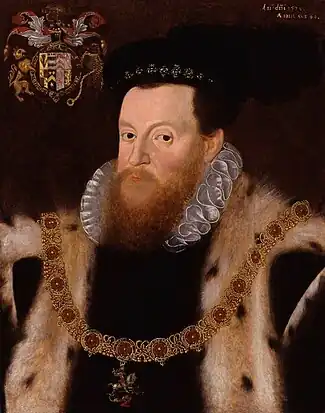Sir William Sidney
Sir William Sidney (c. 1482–1554) was an English courtier under Henry VIII and Edward VI.
Life
He was eldest son of Nicholas Sidney, by Anne, sister of Sir William Brandon. In 1511 he accompanied Thomas Darcy, 1st Baron Darcy de Darcy into Spain as a volunteer against the Moors, and when Darcy, finding his assistance not required, returned almost immediately to England, Sidney and several of his companions remained behind in order to see Madrid. He was hospitably entertained by King Ferdinand, but declined the honour of knighthood from him; and shortly afterwards returned home through France.[1]
As captain of the 'Great Bark' he took part in the naval operations before Brest in April 1513, and later in the year commanded the right wing of the English army at the battle of Flodden. He was knighted for his services, and on 23 March 1514 obtained a grant in tail male of the lordship of Kingston-upon-Hull and the manor of Myton forfeited by the attainder of Edmund de la Pole. In October he accompanied his cousin Charles Brandon, 1st Duke of Suffolk and Thomas Grey, 2nd Marquess of Dorset to Paris, to witness the coronation on 5 November of the Princess Mary as consort of Louis XII, and took a prominent part in the subsequent jousts and festivities. In the following summer he again went to France, charged with the delicate task of announcing the approaching second marriage of the Princess Mary, to the Duke of Suffolk.[1]

It is believed by the Sidney family that Sir William Sidney at that time adopted as a second family crest a porcupine statant azure quills collar and chain or,[2] being the heraldic emblem of King Louis XII.[3]
Sidney was appointed an Esquire of the Body to Henry VIII, and married in 1517. He accompanied the king to the Field of the Cloth of Gold in 1520, and in 1523, during the war with France, took part in the expedition commanded by the Duke of Suffolk. In March 1538 he was appointed tutor and steward of the household to Prince Edward. In 1539 he received a large grant of lands in Kent and Sussex in exchange for those held by him in York and Lincoln. His wife died on 22 October 1543, and on 25 April 1552 Edward VI added to his estates in Kent the manor of Penshurst.[1]
Sidney died at Penshurst on 10 February 1554, and was buried in the parish church.[1]
Death and family

Sidney married Anne Pakenham, daughter of Sir Hugh Pakenham, and widow of Thomas FitzWilliam, (elder brother of William FitzWilliam, 1st Earl of Southampton). Henry Sidney was their son. In the chancel of St John the Baptist, Penshurst is the tomb of Sidney with a memorial tablet, on the sides of which are engraven the escutcheons of his four daughters and their husbands:[1]
- Mary (d. 10 February 1542), eldest daughter, who married Sir William Dormer of Wing, Buckinghamshire,[1][lower-alpha 1]
- Lucy, who married Sir James Harington of Exton Hall, Rutland;
- Anne, who married Sir William FitzWilliam of Milton, Northamptonshire, sometime lord deputy of Ireland.[1]
- Frances, who married of Thomas Radcliffe, 3rd Earl of Sussex.[1]
 Sir Henry Sydney
Sir Henry Sydney_Fitzwilliam.jpg.webp) Lady Anne (Sidney) Fitzwilliam, 1577
Lady Anne (Sidney) Fitzwilliam, 1577 The Countess of Sussex c. 1570-75
The Countess of Sussex c. 1570-75
References
- Mary married Sir William Dormer and was the mother of Thomas, Robert, Jane who became a lady-in-waiting to Queen Mary I, and Anne, who married Sir Walter Hungerford.[4]
- Dunlop 1897, p. 210.
- Montague-Smith, P.W. (ed.), Debrett's Peerage, Baronetage, Knightage and Companionage, Kelly's Directories Ltd, Kingston-upon-Thames, 1968, p.336, Viscount de L'Isle
- "Why is the porcupine part of the Sidney family crest? Penshurst, Kent |". historymagpie.com. Archived from the original on 17 July 2014.
- Richardson III 2011, pp. 254–6.
- Richardson, Douglas (2011). Everingham, Kimball G. (ed.). Magna Carta Ancestry: A Study in Colonial and Medieval Families. Vol. III (2nd ed.). Salt Lake City. ISBN 978-1449966393.
{{cite book}}: CS1 maint: location missing publisher (link)
- Attriution
 This article incorporates text from a publication now in the public domain: Dunlop, Robert (1897). "Sidney, Henry (1529-1586)". In Lee, Sidney (ed.). Dictionary of National Biography. Vol. 52. London: Smith, Elder & Co. pp. 210–217.
This article incorporates text from a publication now in the public domain: Dunlop, Robert (1897). "Sidney, Henry (1529-1586)". In Lee, Sidney (ed.). Dictionary of National Biography. Vol. 52. London: Smith, Elder & Co. pp. 210–217.